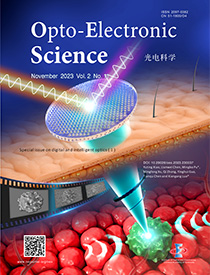2023 Vol. 2, No. 11
Special Issue on Digital and Intelligent Optics (Ⅰ)
Guest Editor: Prof. Junsuk Rho, Pohang University of Science and Technology, Republic of Korea; Prof. Guangwei Hu, Nanyang Technological University, Singapore
Cover story: Xiao YT, Chen LW, Pu MB, Xu MF, Zhang Q et al. Improved spatiotemporal resolution of anti-scattering super-resolution label-free microscopy via synthetic wave 3D metalens imaging. Opto-Electron Sci 2, 230037 (2023).
In the realm of super-resolution microscopy, Synthetic Wave Microscopy (SWM) emerges as a transformative paradigm, revolutionizing our comprehension of biological processes. Confronting the persistent challenge posed by scattering media in thick specimens, which often compromises spatial resolution and image clarity, SWM stands as an unparalleled solution. Moreover, in the domain of live-cell imaging, the pursuit of high temporal resolution for swiftly moving subcellular structures encounters formidable obstacles.
Presenting the core principles of Synthetic Wave Microscopy, we introduce an innovative methodology designed to extract three-dimensional information from thick, unlabeled specimens while circumventing issues associated with photobleaching and phototoxicity. Leveraging multiple-wave interferometry, SWM meticulously reveals the phase information within the region of interest, impervious to the influences of scattering media along the optical path.
Remarkably, SWM achieves a resolution of approximately 0.42 λ/NA at a remarkable imaging speed of up to 106 pixels/s, thereby surpassing the limitations inherent in conventional microscopes. Notably, SWM excels in temporal resolution and sensitivity, positioning itself as a superior alternative to current mainstream microscopes while preserving exceptional super-resolution and anti-scattering capabilities.
The penetration of conventional imaging techniques through scattering media remains a formidable challenge. In stark contrast, SWM consistently retains its efficacy even under conditions characterized by low signal-to-noise ratios. This technology facilitates the visualization of dynamic subcellular structures within live cells, encompassing entities such as the tubular endoplasmic reticulum (ER), lipid droplets, mitochondria, and lysosomes.
Synthetic Wave Microscopy transcends the constraints of contemporary imaging methodologies, offering a profound advancement in super-resolution microscopy. Its capability to provide clarity and precision in the observation of biological structures, even in adverse conditions, marks a significant leap forward in the scientific pursuit of understanding complex biological processes.

-
{{article.year}}, {{article.volume}}({{article.issue}}): {{article.fpage | processPage:article.lpage:6}}. doi: {{article.doi}}{{article.articleStateNameEn}}, Published online {{article.preferredDate | date:'dd MMMM yyyy'}}, doi: {{article.doi}}{{article.articleStateNameEn}}, Accepted Date {{article.acceptedDate | date:'dd MMMM yyyy'}}CSTR: {{article.cstr}}
-
{{article.year}}, {{article.volume}}({{article.issue}}): {{article.fpage | processPage:article.lpage:6}}. doi: {{article.doi}}{{article.articleStateNameEn}}, Published online {{article.preferredDate | date:'dd MMMM yyyy'}}, doi: {{article.doi}}{{article.articleStateNameEn}}, Accepted Date {{article.acceptedDate | date:'dd MMMM yyyy'}}CSTR: {{article.cstr}}

 E-mail Alert
E-mail Alert RSS
RSS


